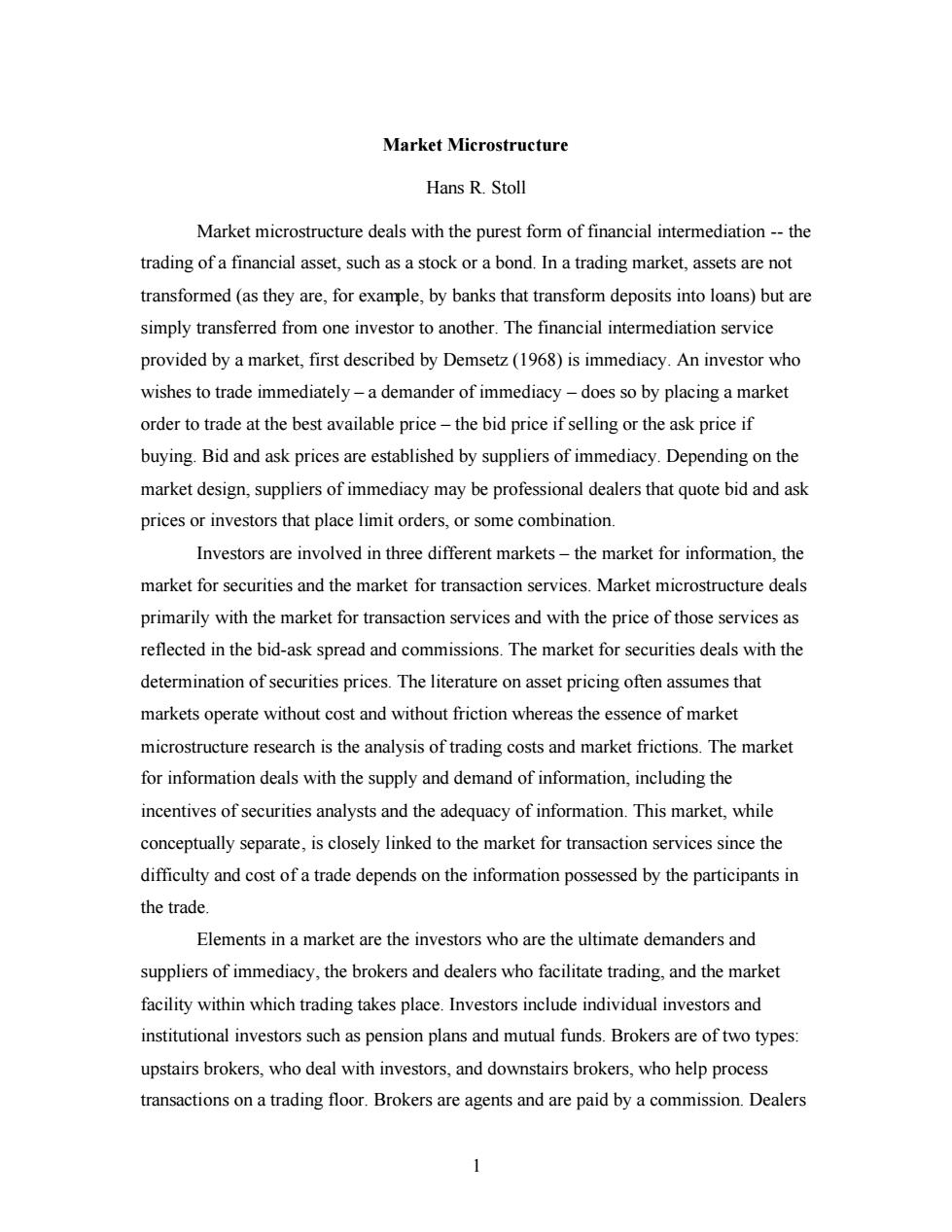正在加载图片...

Market Microstructure Hans R.Stoll Market microstructure deals with the purest form of financial intermediation--the trading of a financial asset,such as a stock or a bond.In a trading market,assets are not transformed(as they are,for example,by banks that transform deposits into loans)but are simply transferred from one investor to another.The financial intermediation service provided by a market,first described by Demsetz(1968)is immediacy.An investor who wishes to trade immediately-a demander of immediacy-does so by placing a market order to trade at the best available price-the bid price if selling or the ask price if buying.Bid and ask prices are established by suppliers of immediacy.Depending on the market design,suppliers of immediacy may be professional dealers that quote bid and ask prices or investors that place limit orders,or some combination. Investors are involved in three different markets-the market for information,the market for securities and the market for transaction services.Market microstructure deals primarily with the market for transaction services and with the price of those services as reflected in the bid-ask spread and commissions.The market for securities deals with the determination of securities prices.The literature on asset pricing often assumes that markets operate without cost and without friction whereas the essence of market microstructure research is the analysis of trading costs and market frictions.The market for information deals with the supply and demand of information,including the incentives of securities analysts and the adequacy of information.This market,while conceptually separate,is closely linked to the market for transaction services since the difficulty and cost of a trade depends on the information possessed by the participants in the trade. Elements in a market are the investors who are the ultimate demanders and suppliers of immediacy,the brokers and dealers who facilitate trading,and the market facility within which trading takes place.Investors include individual investors and institutional investors such as pension plans and mutual funds.Brokers are of two types: upstairs brokers,who deal with investors,and downstairs brokers,who help process transactions on a trading floor.Brokers are agents and are paid by a commission.Dealers 11 Market Microstructure Hans R. Stoll Market microstructure deals with the purest form of financial intermediation -- the trading of a financial asset, such as a stock or a bond. In a trading market, assets are not transformed (as they are, for example, by banks that transform deposits into loans) but are simply transferred from one investor to another. The financial intermediation service provided by a market, first described by Demsetz (1968) is immediacy. An investor who wishes to trade immediately – a demander of immediacy – does so by placing a market order to trade at the best available price – the bid price if selling or the ask price if buying. Bid and ask prices are established by suppliers of immediacy. Depending on the market design, suppliers of immediacy may be professional dealers that quote bid and ask prices or investors that place limit orders, or some combination. Investors are involved in three different markets – the market for information, the market for securities and the market for transaction services. Market microstructure deals primarily with the market for transaction services and with the price of those services as reflected in the bid-ask spread and commissions. The market for securities deals with the determination of securities prices. The literature on asset pricing often assumes that markets operate without cost and without friction whereas the essence of market microstructure research is the analysis of trading costs and market frictions. The market for information deals with the supply and demand of information, including the incentives of securities analysts and the adequacy of information. This market, while conceptually separate, is closely linked to the market for transaction services since the difficulty and cost of a trade depends on the information possessed by the participants in the trade. Elements in a market are the investors who are the ultimate demanders and suppliers of immediacy, the brokers and dealers who facilitate trading, and the market facility within which trading takes place. Investors include individual investors and institutional investors such as pension plans and mutual funds. Brokers are of two types: upstairs brokers, who deal with investors, and downstairs brokers, who help process transactions on a trading floor. Brokers are agents and are paid by a commission. Dealers